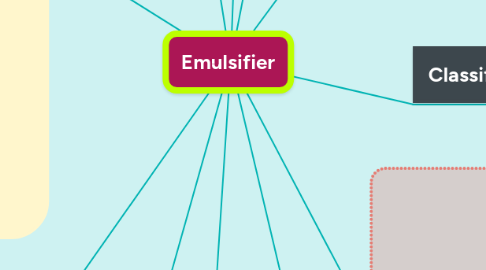
1. Surface active property
1.1. Aid emulsification
1.2. Non stick coating to prevent food from sticking to one another
1.3. Functional ingredients in consumer aerosol cooking sprays
1.4. As a releasing agent for pans and oven belts
1.5. Improve powder wettability and disperbility
2. Function
2.1. Surface Active Property
2.1.1. Emulsification
2.1.2. Dispersion
2.1.2.1. Eg: cocoa powder
2.1.2.1.1. Prevent lump formation
2.1.3. Foaming agent
2.1.3.1. Eg: cake, ice cream, whipped topping
2.1.4. Defoamiing agent
2.1.4.1. Eg: Tofu, fermentation industry, jam
2.1.5. Wetting
2.1.5.1. Eg: Powdered food, chewing gum
2.2. Starch complexing
2.2.1. Protection of starch granule
2.2.1.1. Eg: Instant mashed potato
2.2.1.1.1. Smooth texture
2.2.2. Retard retrogradation and anti-staling
2.2.2.1. Eg: Bread, cake
2.2.3. Prevent sticking
2.2.3.1. Eg: Pasta, noodle, rice
2.2.4. Prevent gelatinization
2.2.4.1. Eg: Flour paste, desserts
2.3. Modifying ability of fats and oils
2.3.1. Crystal modiification
2.3.1.1. Eg: Margarine, shortening, chocolate
2.3.1.1.1. Retard fat bloom
2.3.2. Creaming ability
2.3.3. Water holding ability
2.3.4. Improve plasticity
2.4. Protein modifying ability
2.4.1. Gluten modification
2.4.1.1. Eg: Dough conditioner
3. Example
3.1. Lecithin
3.1.1. isolated from egg yolk, soybean, rapeseed and sunflowers
3.2. PGPR
3.2.1. improves the moulding properties of molten chocolate for chocolate coatings to flow properly during the enrobing process
3.2.2. limit fat bloom
3.2.3. used as a viscosity-reducing agent for chocolate
3.3. AMP
3.4. Mono- and diglycerides
3.5. sodium stearoyl lactylate
3.6. Hydrocolloid emulsifier
3.6.1. Gum arabic
3.6.2. Locust bean gum
3.6.3. Xanthan gum
3.7. Citric acid ester
3.7.1. Highly hydrophilic emulsifier
3.7.2. used as an emulsion stabilizer for mayonnaise and dressing by utilizing its strong acid-resistance
3.7.3. used for margarine, dairy products such as coffee whitener and cream
3.8. DATEM
3.8.1. can act on starch and protein, thus it is used as a dough conditioner.
4. Applicatoion
4.1. Bread
4.1.1. Dough strengtheners
4.1.1.1. Improve texture and volume
4.1.1.1.1. Eg: Diacetyl tartaric acid esters, sodium or calcium stearoyl-2-lactylate
4.1.2. Dough conditioner
4.1.2.1. Softer crumb structure and increase shelf life
4.1.2.1.1. Eg: mono-diglycerides of fatty acids
4.2. Chocolate
4.2.1. Molding
4.2.2. Inhibit crystal growth
4.2.3. Delay fat bloom
4.2.3.1. Eg: Sorbitan tristearate
4.3. Ice cream
4.3.1. Smoother texture
4.3.2. Does not melt rapidly
4.3.3. Improve freeze thaw stability
4.3.4. Eg: lecithin, mono-diglycerides, polysorbates
4.4. Margarine
4.4.1. Prevent splattering
4.4.1.1. Eg: citric acid esters of mono- and diglycerides
4.4.2. Desired texture, plasticity, and taste
4.4.3. Enhance spreadability
4.5. Processed meat
4.5.1. stabilize the fat and moisture to prevent excessive tosses or product failure
4.5.1.1. Eg: mono- and diglycerides, citric acid esters
4.6. Confectionery
4.6.1. Controlling viscosity can improve efficiency during production
4.6.2. minimize loss of product during handling
5. Emulsion
5.1. Formed when one immiscible phase (dispersed phase) is dispersed in another (continuous phase) through mechanical action.
5.2. apply shearing power, break up the dispersed phase into smaller particles and distribute the particles throughout the continuous phase
5.2.1. Shaking < Whisking < Blending < Homogenising
5.3. The smaller the particles of the dispersed phase, the more stable emulsion
5.4. Two type
5.4.1. Oil in water
5.4.1.1. Eg: milk, cream, mayonnaise, cake batter
5.4.2. Water in oil
5.4.2.1. Eg: margarine, butter, spreads
6. Structure
6.1. Ampiphilic
6.1.1. Hydrophobic (lipophilic) tail
6.1.1.1. Align towards lipid phase
6.1.2. Hydrophilic head
6.1.2.1. Align towards water phase
6.1.3. Form electrically charged surface between two immiscible phase causing particles to repel one another rather than coalesce
7. Type
7.1. Protein based
7.1.1. Adsorption at the interphase between two immiscible phase
7.1.1.1. Form viscoelastic gel
7.1.1.1.1. Accommodates deformation and prevent coalescence
7.1.2. Unfold and exhibit hydrophobic groups to the hydrophobic phase of the emulsion.
7.1.3. stabilize emulsions through protein-protein interactions that form a stiff, gel-like film (sometimes multi- layered), which has viscoelastic properties.
7.1.3.1. When films are thinned, protein molecules stabilize emulsions by their cohesive nature which dissipates changes across the film
7.2. Lipid based
7.2.1. provide stability by causing the rapid diffusion of liquid from areas of high surface tension to regions of low tension, which occurs when there is a gradient in the surface tension at the interface
7.3. Low molecular weight surfactants
7.3.1. stabilize by congregating at the surface interface between an aqueous and air or oil phase.
8. Hydrophilic-Lipophilic Balance (HLB)
8.1. ratio of the weight percentages of the hydrophilic and hydrophobic groups in an emulsifier
8.2. dictate the relative amphiphilicity of a surfactant
8.3. Values are affected by temperature
8.4. range from 0 to 20
8.4.1. Higher HLB values are more water-soluble
8.4.1.1. aqueous system
8.4.1.1.1. Eg: Hydrophilic sugar esters
8.4.2. Low HLB value are more oil-soluble
8.4.2.1. oil/fat continuous product
9. Surface tension
9.1. The amount of energy required to increase the surface area between liquid and a gas
10. Interfacial tension
10.1. The amount of energy required to increase the interfacial area between two immiscible liquids
10.1.1. Larger interfacial area--- better emulsifying effect
11. Classification
11.1. Non-ionic
11.1.1. no ionization in water
11.1.2. tend to have large, bulky head groups that point away from the oil droplet. These polar head groups clash and tangle with head groups on other water droplets, sterically hindering the droplets from coming together.
11.2. Ionic
11.2.1. When charged emulsifiers coat droplets in an o/w emulsion, the positive or negative charges on the outside of the oil droplets electrostatically repel each other, helping to keep the droplets separated
11.2.1.1. Cationic
11.2.1.1.1. Used in acidic or neutral condition
11.2.1.2. Anionic
11.2.1.2.1. Used in alkaline or neutral condition

